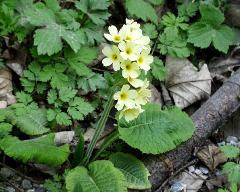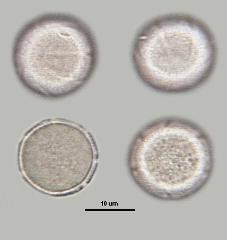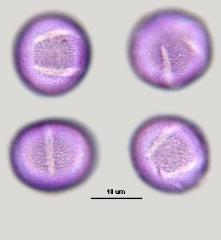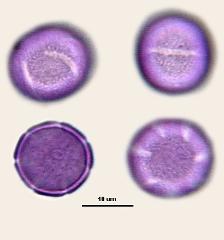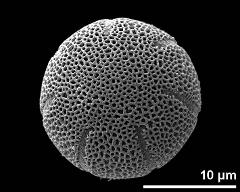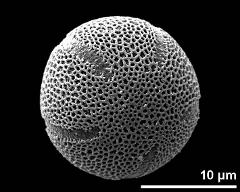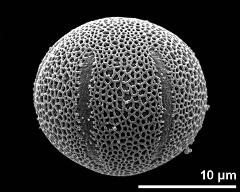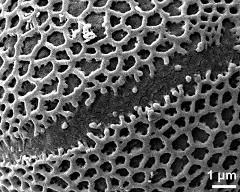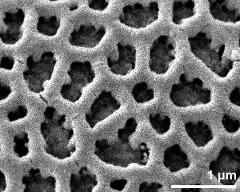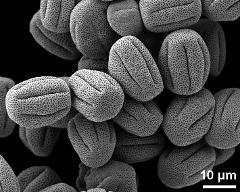Primula elatior
Taxonomy: Angiospermae, Ericales, Primulaceae, Primula
Links: http://flora.nhm-wien.ac.at/Seiten-Arten/Primula-elatior.htm
Published: 2021-06-23
Pollen Description
Shape, Size and Aperture
pollen unit: monad, dispersal unit and peculiarities: monad, size (pollen unit): small (10-25 µm), size of hydrated pollen (LM): 16-20 µm, 11-15 µm, shortest polar axis in equatorial view (LM): 11-15 µm, longest polar axis in equatorial view (LM): -, shortest diameter in equatorial or polar view (LM): 16-20 µm, longest diameter in equatorial or polar view (LM): 16-20 µm, pollen class: colpate, polarity: isopolar, P/E-ratio: -, shape: spheroidal, outline in polar view: circular, dominant orientation (LM): oblique, P/E-ratio (dry pollen): prolate, shape (dry pollen): -, outline in polar view (dry pollen): lobate, infoldings (dry pollen): aperture(s) sunken, aperture number: >6, aperture type: colpus, aperture condition: stephanocolpate, colpate, aperture peculiarities: -
Ornamentation and Structure
LM ornamentation LM: scabrate, nexine: -, sexine: -, SEM ornamentation SEM: microreticulate, suprasculpture SEM: -, TEM tectum: -, infratectum: -, foot layer: -, endexine: -, intine: -, wall peculiarities: -, supratectal element: -
Miscellaneous
pollen coatings: -, reserves in cytoplasm: -, cell number: -, Ubisch bodies: -
Annotations: number of apertures varies from 5 to 7; longstyled flower; heterostyly
Author(s) of diagnosis: Halbritter, Heidemarie; Heigl, Helmut; Auer, Waltraud
Pictures
Picture legend
- flower(s), photographer: Halbritter, H.
- hydrated pollen - fresh, glycerine, unstained, photographer: Heigl, H.
- hydrated pollen - fresh, glycerine, ruthenium red, photographer: Heigl, H.
- hydrated pollen - fresh, glycerine, ruthenium red, photographer: Heigl, H.
- slightly oblique polar view; 7 colpi - fresh, rehydrated (water) & critical point dried & sputter coated with gold, photographer: Halbritter, H.
- slightly oblique polar view; 5 colpi - fresh, rehydrated (water) & critical point dried & sputter coated with gold, photographer: Halbritter, H.
- equatorial view - fresh, rehydrated (water) & critical point dried & sputter coated with gold, photographer: Halbritter, H.
- detail of aperture - fresh, rehydrated (water) & critical point dried & sputter coated with gold, photographer: Halbritter, H.
- exine surface - fresh, rehydrated (water) & critical point dried & sputter coated with gold, photographer: Halbritter, H.
- dry pollen grains - dry, sputter coated with gold, photographer: Halbritter, H.
Literature
- (1984) Pollen morphology and heterostyly - a systematic and critical account. Adv Pollen - Spore Res 12: 79-126
- (1993) Pollen exine dimorphism in ten heterostylous species. J Palynol 29: 77-88
- (1985) Morfología polínica de la familia Primulaceae en Andalucía occidental. An Asoc Palinol Leng Esp 2: 107-115
- (1970) Morphologie des grains de pollen de quelques Myrtaceae et Primulaceae. Vest mosk Univ 6 25: 47-52
- (1970) The Primulaceae of Taiwan. Taiwania 15: 51-72
- (1974) Scanning electron microscopic observations of pollen grains and stigma in the self incompatible heteromorphic species Primula malacoides Franch. and Forsythia x intermedia Zab and genetics of sporopollenin deposition. Euphytica 23: 337-344
- (1986) The evolution of distyly in Primula vulgaris. Biol J Linn Soc 29: 123-137
- (1974) Primulaceae. Rev Palaeobot Palynol, NEPF 17: 31-70
- (1993) Primula. Batsford Ltd, London : 299 pp
- (1962) Die Bedeutung der Pollenmorphologie für die Taxonomie der Primulaceae-Primuloideae. Feddes Rep 65: 149-214
- (1968) Floral anatomy and embryology of Primula floribunda Wall. Phytomorphology 18: 105-113
- (1960) Considérations palynologiques sur les représentants de la famille des Primulacées de la flora Roumaine. Com Ac RPR 10: 111-118
- (1961) Studies in Primulaceae - II. An account of Primula subgenus Sphondylia with a review of the subdivisions of the genus. Ab Univ Bergen matnaturv Ser 11: 1-49
- (1998) Preparing living pollen material for scanning electron microscopy using 2,2-dimethoxypropane (DMP) and criticalpoint drying. Biotechnic Histochem 73: 137–143
Copyright and Citation
Cite this publication as:
Halbritter H., Heigl H., Auer W. 2021. Primula elatior. In: PalDat - A palynological database. https://www.paldat.org/pub/Primula_elatior/306329;jsessionid=890E44E79568AA3417BB901CD88A7920; accessed 2025-10-29

